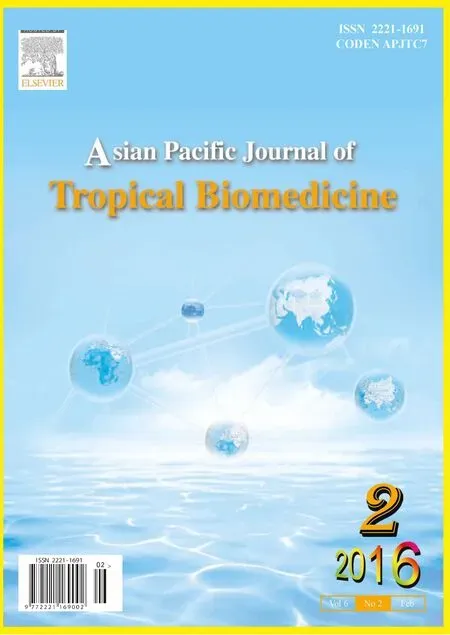Feasibility of using melatonin as a new treatment agent for Ebola virus infection: A gene ontology study
Beuy Joob, Viroj WiwanitkitSanitation 1 Medical Academic Center, Bangkok, ThailandHainan Medical University, Haikou, Hainan, ChinaFaculty of Medicine, University of Nis, Nis, SerbiaJoseph Ayobabalola University, Osun State, NigeriaDr DY Patil Medical University, Navi Mumbai, IndiaSurin Rajabhat University, Surin, Thailand
?
Feasibility of using melatonin as a new treatment agent for Ebola virus infection: A gene ontology study
Beuy Joob1*, Viroj Wiwanitkit2,3,4,5,61Sanitation 1 Medical Academic Center, Bangkok, Thailand
2Hainan Medical University, Haikou, Hainan, China
3Faculty of Medicine, University of Nis, Nis, Serbia
4Joseph Ayobabalola University, Osun State, Nigeria
5Dr DY Patil Medical University, Navi Mumbai, India
6Surin Rajabhat University, Surin, Thailand
Letter to the Editor http://dx.doi.org/10.1016/j.apjtb.2015.01.031
E-mail: beuyjoob@hotmail.com
Peer review under responsibility of Hainan Medical University. The journal implements double-blind peer review practiced by specially invited international editorial board members.
Article history:
Received 6 Oct 2014
Accepted 2 Jan 2015
Available online 18 Dec 2015
2221-1691/Copyright?2016 Hainan Medical University. Production and hosting by Elsevier B.V. This is an open access article under the CC BY-NC-ND license (http:// creativecommons.org/licenses/by-nc-nd/4.0/).
Dear Editor,
The effective treatment of the present outbreak Ebola virus is the big challenge for the medical society. Several new therapeutic options are ongoing research. The development of new antiviral and vaccine is the hope for successful management of the infection. However, there are also other alternative ideas for treatment of the Ebola virus infection. An interesting idea is the use of melatonin for treatment. This has just been proposed in Journal of Pineal Research in September 2014. The idea is based on the observation that melatonin is useful for management of sepsis via modification of cytokine cascade[1]. It is hypothesized that melatonin will be useful for management of Ebola virus infection [2]. However, there is still no proof from in vitro on in vivo study. Here, the authors try to use the standard bioinformatics, gene ontology, for prediction of the usefulness of the melatonin in management of Ebola virus infection. The standard tool namely MANGO is used for gene ontology study in this work. According to the study, the main derived ontology results for melatonin and the virus is shown in Table 1.
According to this report, we can identify many interesting molecular functions of melatonin and virus. Focusing on the virus, the cation antiporter activity is concordant with previous report by Han and Harty [3] whereas targeting to peroxisome is the new observation. Considering the identified function of melatonin, the laminin receptor activity and collagen binding should be specially focused. In fact, the interrelationship between laminin, collagen and peroxisome is mentioned in the literature [4]. The laminin effectively co-express with peroxisome in stabilizing of cell [4]. According to the ontology, melatonin has the property as laminin receptor that implies promoting laminin functioning whereas the virus has activity to target to peroxisome. Hence, the melatonin can promote laminin activity that can counteract to peroxisome targeting by virus and this might be a possible explanation of the usefulness of using melatonin treatment for Ebola virus infection. Using melatonin treatment is an exact challenging therapeutic alternative for patients infected with Ebola virus.

Table 1The main derived ontology results for melatonin and the virus.
Conflict of interest statement
We declare that we have no conflict of interest.
References
[1] Tan DX, Korkmaz A, Reiter RJ, Manchester LC. Ebola virus disease: potential use of melatonin as a treatment. J Pineal Res 2014; 57: 381-4.
[2] Vielma JR, Bonilla E, Chac′?n-Bonilla L, Mora M, Medina-Leendertz S, Bravo Y. Effects of melatonin on oxidative stress, andresistance to bacterial, parasitic, and viral infections: a review. Acta Trop 2014; 137: 31-8.
[3] Han Z, Harty RN. Influence of calcium/calmodulin on budding of Ebola VLPs: implications for the involvement of the Ras/Raf/MEK/ ERK pathway. Virus Genes 2007; 35(3): 511-20.
[4] Depreter M, Nardacci R, Tytgat T, Espeel M, Stefanini S, Roels F. Maturation of the liver-specific peroxisome versus laminin, collagen IV and integrin expression. Biol Cell 1998; 90(9): 641-52.
*Corresponding author:Beuy Joob, Sanitation 1 Medical Academic Center, Bangkok, Thailand.
 Asian Pacific Journal of Tropical Biomedicine2016年2期
Asian Pacific Journal of Tropical Biomedicine2016年2期
- Asian Pacific Journal of Tropical Biomedicine的其它文章
- Inhibitory actions of Pseuderanthemum palatiferum (Nees) Radlk. leaf ethanolic extract and its phytochemicals against carbohydrate-digesting enzymes
- Prevalence of refractive errors among primary school children in a tropical area, Southeastern Iran
- Inhibitory effect of gold nanoparticles conjugated with interferon gamma and methionine on breast cancer cell line
- Step-by-step external fixation of unstable pelvis with separate anterior and posterior modules
- Evaluation of imatinib mesylate (Gleevec) on KAI1/CD82 gene expression in breast cancer MCF-7 cells using quantitative real-time PCR
- Anti-hyperglycemic effects of aqueous Lenzites betulina extracts from the Philippines on the blood glucose levels of the ICR mice (Mus musculus)
